
Text © Giuseppe Mazza

English translation by Mario Beltramini
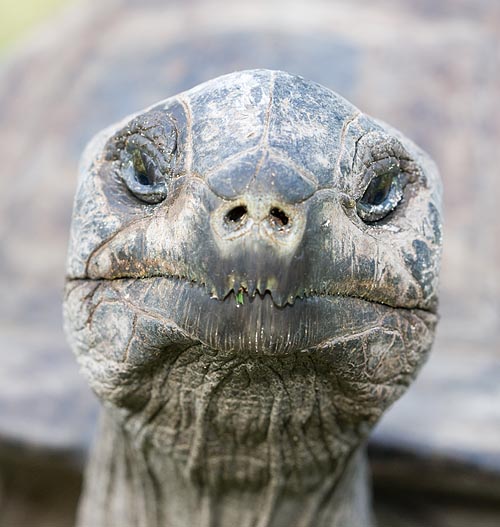 A glance is sufficient to understand at once that they are animals belonging to a different world.
A glance is sufficient to understand at once that they are animals belonging to a different world.
An ET-like head, and a profile which recalls dinosaurs ans star wars armoured tanks.
Fossils living on fragments of Gondwana, which survived to evolution over turnings thanks to the geographic isolation which has protected them for millennia from modern plunderers.
Only a few centuries ago, the giant turtles of Seychelles were spread out in various islands with four species.
Then, man came. For the sail boats, they were an easy source of fresh meat. In those times there were no cold rooms aboard, and an animal which could stay six months without food and water, was a source of precious proteins for the crew.
And, furthermore, giant turtles were even tasty. So that natives did eat them happily with their families on important recurrences, just like our turkeys for Christmas. Direct slaughter, then, and indirect too, because at the same time domestic animals and rats which had slyly left the vessels, were giving the finishing blow destroying the eggs and the little ones.
The fact remains that nowadays only one species survives, the Dipsochelys elephantina, present in nature with 150.000 individuals in the atoll of Aldabra, and in that small, granite island of Curieuse, where I did shot these photos.
They have been reintroduced here 30 years ago, with the purpose of showing them to the tourists in a more accessible place than Aldabra, which is 1200 km far away from the capital, and to give them the possibility to breed in a less hostile habitat than the reef, on the land of their ancestors.
With almost three generations behind them, they vaunt nowadays the second world population of the species. And a similar experiment is being done on the private island Fregate, where an incredible hotel has arisen, agri tourism-like, with 16 sumptuous villas for billionaire ambient lovers.
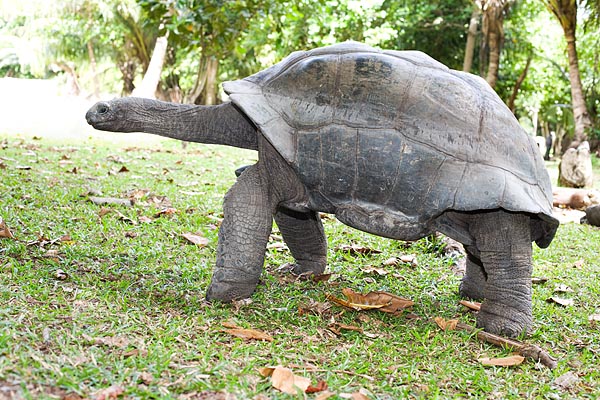 A means also to lessen the extinction risks.
A means also to lessen the extinction risks.
But is the remaining species is not threatened any more, to such an extent to be shown only as “vulnerable” on the Annex II of the CITES, on the scientific point of view, herpetologists have not been able to reach an agreement on their name.
Till a few years ago, the Seychelles turtle was named Testudo gigantea, in antithesis of the Galapagos turtle (Chelonoidis niger), slightly smaller and without the large uneven nape plate.
After having been renamed Geochelone gigantea, “Turtles of the world”, important reference work by Franck Bonin, Bernard Devaux and Alain Dupré, published in 2006, did label it as Dipsochelys elephantina, whilst another scholar, Jack Frazier, talks of Aldabrachelys gigantea, Peter Pritchard of Aldabrachelys elephantina and Ron Gerlach quite creates three species: Dipsochelys dussumieri, Dipsochelys hololissa and Dipsochelys arnoldi.
Today (2019) prevails Aldabrachelys gigantea.
In Curieuse, giant turtles are active mainly early in the morning or late in the afternoon, when it is not too warm. They do not hold teeth, but sound jaws, so much sharpened to cut a blade of grass. And when needed, even if they are basically social, calm and quiet animals, they are capable of unbelievable sprints and of a certain aggressiveness.
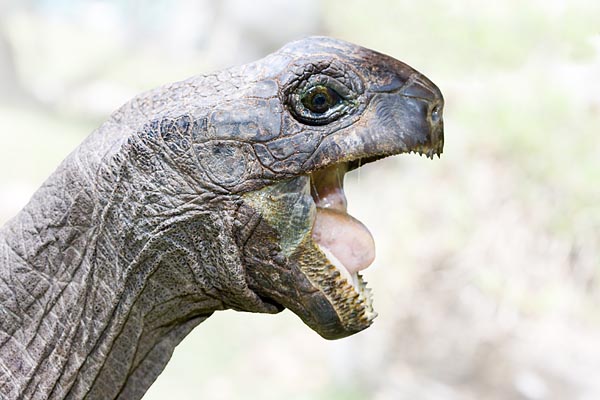 During my visit, an adult male, christened “Tyson” by the watchmen, was inexplicably biting one of them.
During my visit, an adult male, christened “Tyson” by the watchmen, was inexplicably biting one of them.
When I was getting close to him to take a photo, he was just ignoring me; but as soon as he saw the ranger who had been assigned to me, he moved violently against him with the mouth wide open and surely with not pacific purposes, incredibly brisk in spite of his 200 Kilos.
Perhaps the reminiscence of a suffered injustice, or maybe the intolerance to authority for territorial reasons.
With their long telescopic necks, the Seychelles turtles can reach dangerously, in an instant, where less you can expect, and graze without effort up and down.
Where they are more numerous, in Laraie Bay, which welcomes tourists outboard boats, eat today and eat tomorrow, the grass grows by this time so low, that it looks like that a grass cutter has just passed by.
They live on all all available vegetables, without ignoring small invertebrates and left-overs from barbecues. Papayas, salads, mangoes and bread loaves.
They appreciate very much mangrove leaves, and, in spite of their size, they do not hesitate in making their way in their intricate structures, regardless of the roots which come to surface like crags or elbows.
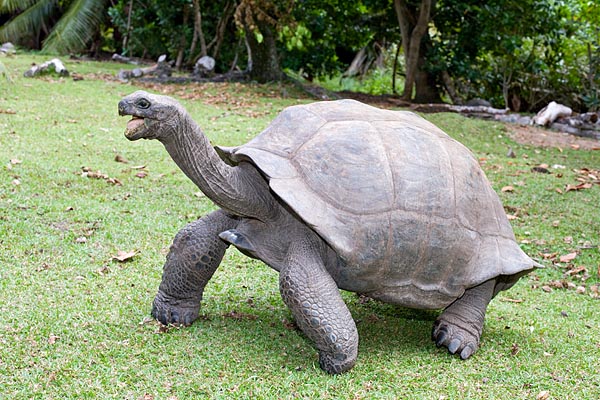 Here the border of the beach is often covered by conical shells, which have been happily crunched after banquets of leaves, while the tide visibly rises.
Here the border of the beach is often covered by conical shells, which have been happily crunched after banquets of leaves, while the tide visibly rises.
A rich contribution of calcium to the carapace. And who cares if waves come? Also in the sea Seychelles turtles can swim very well.
But for their nap the favourite place is in the shade, close to the large puddles of rainy water, where they can drink, and enjoy refreshing baths in the mud.
It has been remarked that each one has a fixed, preferred place, and every day she follows the same route. A life without stress, which allows to overcome the 140 years of age.
Even the tourists do not seem to disturb them too much.
If they are caressed on the neck or massaged on their back legs, they stand up majestically for unforgettable souvenir photos; and, watchful to baskets, they have become clever in beggary.
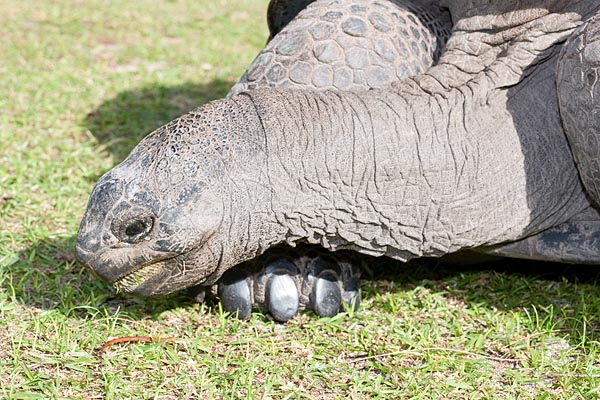 When in 1744, the French navigator Lazare Picault discovered Curieuse island, this one was inhabited only by giant turtles and crocodiles.
When in 1744, the French navigator Lazare Picault discovered Curieuse island, this one was inhabited only by giant turtles and crocodiles.
In 1768, Lampériaire, Commander of the French schooner “La Curieuse”, took officially possession of the island on the account of France, and christened same after his vessel’s name.
He discovers the “Coco de mer”, the famous bilobated coconuts of the Lodoicea maldivica, the tree of the forbidden fruits, which evoke feminine forms, and takes on board a good quantity of them for the Governor of Mauritius island, the French naturalist, Pierre Piovre.
The price of these mysterious fruits, which were thought to grow up on the bottom of the sea, collapsed and the exploitation of the island begins, with loads of 300 nuts per year, and the destruction of the uncomfortable crocodiles, not to talk about the unarmed turtles which, one after the other, concluded their lives into a cauldron.
In those times, by sure, nobody worried about the protection of nature.
And only in 1874 a voice of dissent did arise. The great English naturalist, Charles Darwin, who had studied during his voyages the giant Galapagos turtles, writes to the Governor of Mauritius island, insisting on the necessity of a protection, seen “the major scientific interest of these prehistoric animals”.
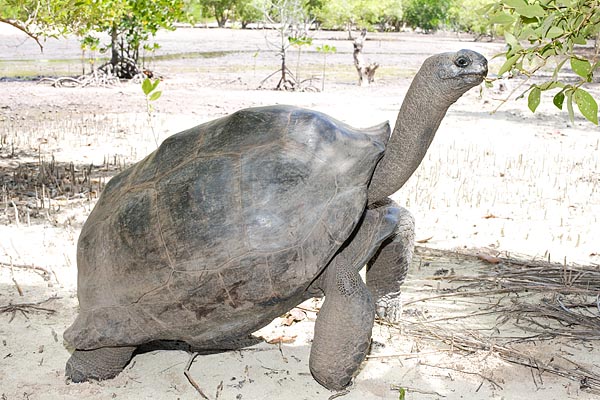 In order to save them, he suggested to move a number of them from Aldabra to the granite Seychelles islands.
In order to save them, he suggested to move a number of them from Aldabra to the granite Seychelles islands.
But yet another century will have to pass by.
After years of discussions, at last Curiose was chosen as “second home” for the giant turtles. And between 1978 and 1982, after the closing of a leper house, 248 specimens came from Aldabra.
Everything seemed to proceed in the best way. But a few years later, in spite of optimism, the population of turtles was again rapidly declining, owing to wild hunting and to natural predators.
In 1988 also the Zoological Association of London mobilizes, and with international help, a “nursery for turtles” is built close to the watchmen little house.
The females, a ranger tells me, lay their eggs mostly during night time, in nests deep even 30 cm, dug in the sand. Then they close the nests and then carefully level the sand.
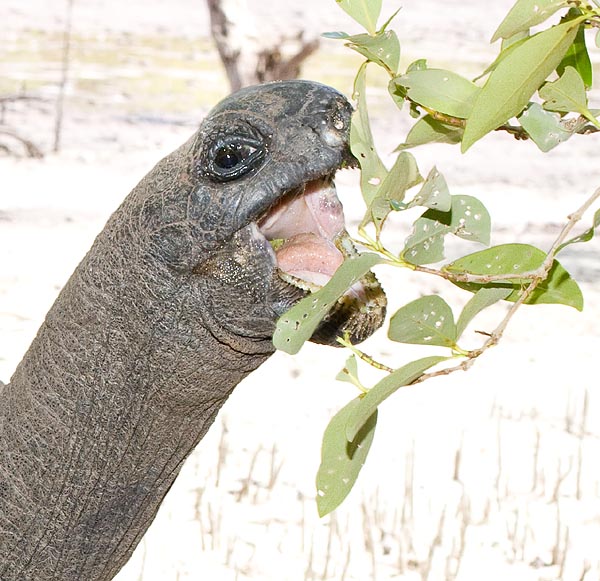 But on an island of one km and a half by three, the places suitable for laying eggs are not so many. And we notice this immediately, in the morning, due to the typical traces on the sand.
But on an island of one km and a half by three, the places suitable for laying eggs are not so many. And we notice this immediately, in the morning, due to the typical traces on the sand.
The eggs, similar to tennis balls, are carefully gathered and put under the sand in the nursery.
Here they will open safely without any risk, and the little ones are then brought up for five years in large enclosures.
They will get free only when the carapace will reach the 40 cm of size, and being by this time adults, they will be able to feed and live autonomously.
In 2001, also 29 specimens from Saint Ann island have come to Curieuse, and after the last census done in 2006, there were 128 heads.
In my opinion, today all premises are present for a healthy increase of the drove.
But the watchmen, the island is uninhabited. No outlaw hunters. And protected as they are, and well fed, the giant turtles should reproduce rapidly.
In nature, in Aldabra, they reach their sexual maturity when 15 – 25 years old. Here, much before, as mating, for these animals is not matter of age, but of weight.
It has been noted that usually they mate, and lay the first eggs when the carapace is greater than the half of the adult’s size. Here they have as much water and food as they want, and the carapace increases visibly.
Also tourism seems to be well organized. Hotels do not exist in Curieuse. The only buildings of the island are the “Doctor house”, the old house for lepers, nowadays transformed in museum and information centre for the park, and the main office of the rangers.
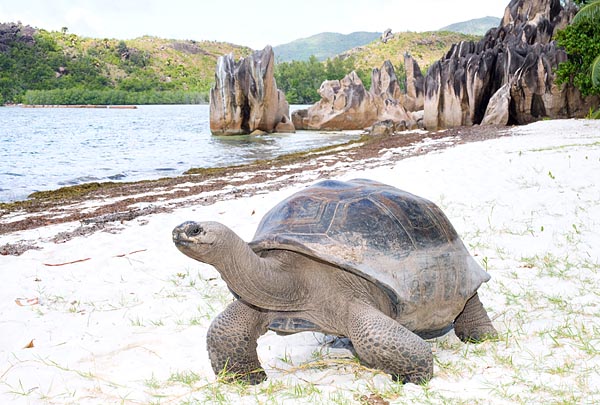 Visitors do arrive by mid morning, by small boats coming from Praslin, the second largest island of the archipelago, after Mahé. And they leave by four o’clock in the afternoon, after a guided visit which takes place, on footbridges, among the gorgeous mangrove formations.
Visitors do arrive by mid morning, by small boats coming from Praslin, the second largest island of the archipelago, after Mahé. And they leave by four o’clock in the afternoon, after a guided visit which takes place, on footbridges, among the gorgeous mangrove formations.
Dreamy beaches, surrounded by fanciful granite rocks which arise, like knives, from the white coralline sand. The famous bilobated nuts. Also a picnic well organized with rice, vegetables, and tasty grilled fresh fish.
In a straight line, there are only 2 km from Praslin, but to make them is not always easy, as you have to keep in mind the tides, the emerging reefs, the waves and the weather which can change in a moment.
When going, my wife and self, we had an easy passage, even if sometimes we could hardly keep steady the photographic bags on the small mattresses of the boat.
But, on the way back, in order to avoid a dark approaching cloud, with relevant shower, the boat was pitching almost vertical, pushed by two motors running at maximum power, with terrible rebounds on the waves. Mattresses were now of no use, and in that sort of marine rodeo, we had to sway the bags up and down, by our arms, protecting them in the best possible way with plastic clothes, while we were getting in our faces all the anomalous waves.
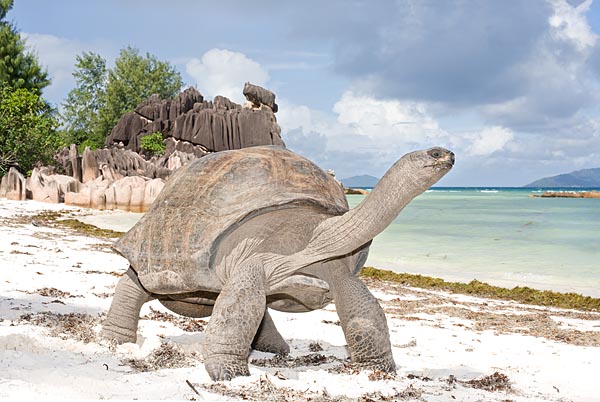 With us there was also a big team of the Japanese TV, which we had met the previous week at Praslin, in the Vallée de Mai, where stands an ancient and thick forest of Coco de mer.
With us there was also a big team of the Japanese TV, which we had met the previous week at Praslin, in the Vallée de Mai, where stands an ancient and thick forest of Coco de mer.
And we were planning to go later to Bird Island, to film the heaviest turtle in the world, Esmeralda, which, in spite of the name, is a male, and weighs more than 300 Kg.
It seems that it’s 170 or even 200 years old. But here we enter fully the legends which exist concerning Seychelles turtles.
They relate of Jonathan, a particularly long-lived specimen which should have lived together with Napoleon in Saint Helena island; and of Adwaitya, given as token to the General Major Robert Clive for the Company of India on 1751, taken later in 1875 by the zoo of Calcutta, and here passed away in 2006, being 255 years old.
Some relate about a turtle which had reached Africa by swimming, or of colossal males with more than two metres of carapace.
What is sure, it’s that the currents can have well carried in open seas an animal voracious of mangroves. An also nowadays, in captivity, we find, exceptionally, specimens with a carapace of 160 cm, to which we can add, and here stands the misunderstanding, about 40 cm of neck, and the tail.
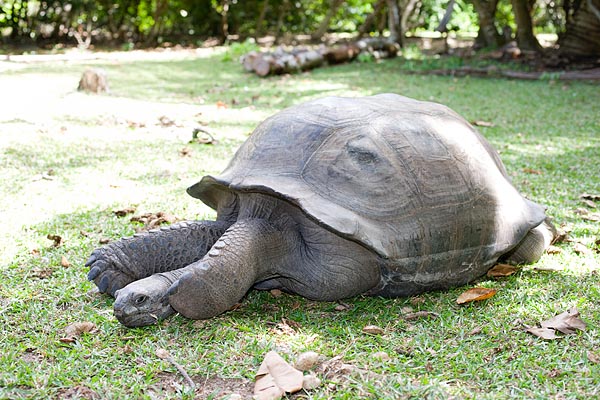 This last in the male is longer and lower at the base.
This last in the male is longer and lower at the base.
But apart the fact that females are lighter, with carapaces of a metre at the best, the distinguishing element between the two sexes is the big plate.
Flat in the young specimens, up to about 20 cm, and then distinctly hollow in the males.
An evolution trick, which, added to the difference in weight, allows to the strong sex to keep well steady the female during the mating.
Preliminaries, usually, are not violent.
At the worst, some hits with the carapace or some bites, in order to persuade the female to draw back her head and paws and to stop.
Thus, males climb, and the game is over.
It’s surprising, at each pushing, their loud grumbling scream, which can be heard even 100 metres far away.
Seychelles turtles are dumb animals, without vocal cords, and in this occasion the males hiss.
It seems that a part of the larynx vibrates owing to the rapid ejection of air. On the sides, we can notice in fact two stripes of elastic fibres which resound, like a cord, when, due to the excitement the breathing becomes rapid.
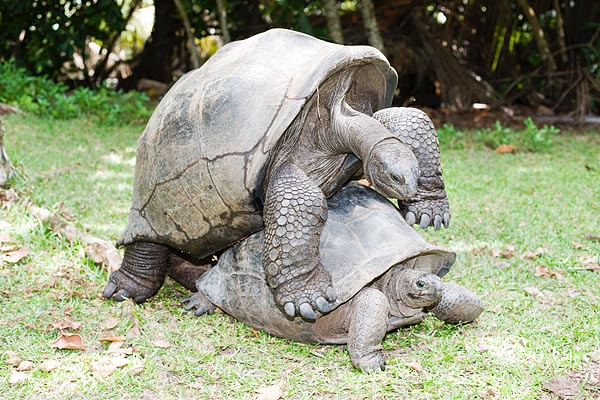 Under the carapace, in the upper side, the turtles in fact have, like us, two large lungs.
Under the carapace, in the upper side, the turtles in fact have, like us, two large lungs.
But, as the thorax is caged, breathing happens thanks to special muscles, placed just over the fore legs.
When they contract, the space of the thoracic cavity widens, thus creating an eddy. And when they spread out, they push up the entrails, and empty the lungs.
The carapace, is not, as many think, an inactive bone, a shield solid like a rock placed on the back, but a very sensitive and delicate area, connected to the nervous centres.
In fact, the animal reacts when touched.
Due to the absence of natural foes, the carapace of Seychelles giant turtles has lost, in fact, in the millennia, great part of its protective function, and has become very often a sort of a leathery shield.
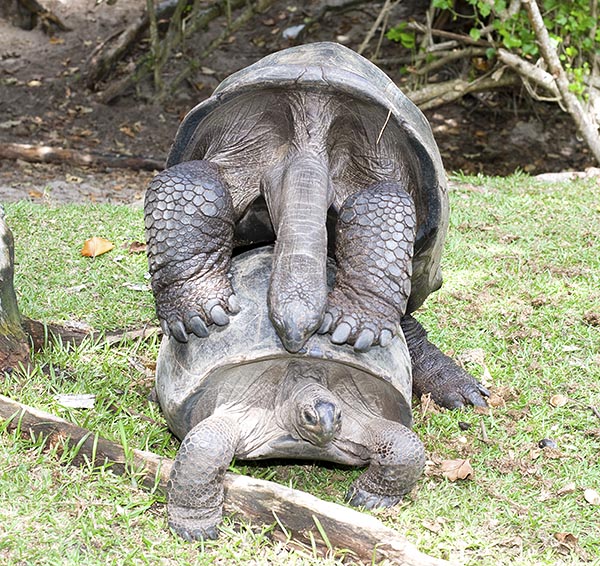 Beyond the respect which is due to every living being, we have not to ride these animals, as once most stupid tourists were doing, and also when we need to transport them, we must be careful, because they can easily suffer of internal damages.
Beyond the respect which is due to every living being, we have not to ride these animals, as once most stupid tourists were doing, and also when we need to transport them, we must be careful, because they can easily suffer of internal damages.
In Curiose, the Seychelles turtles breed all over the year, the peak is between October and March, when rains are frequent, and the ground is easier to dig.
Once fecundated, females maintain the semen for a long time, and can lay down even after months, when they feel ready and the atmospheric conditions are the best.
In order to dig the nest, they often soften the ground with litres of urine. Then, from under the tail, eggs draw out, one by one. White balls of 65 – 80grams, with 5 – 7 cm of diameter.
They are laid down delicately, with the back legs, one over the other, in the bottom of the hole.
Their number is much variable.
In general, there are from 9 to 21 eggs, but even more if the female has a good size, and even only one, when it’s the first time. Also the intervals between reproductive cycles, depend on the age, the feeding, and the health status of the female, and vary between 6 months and two years.
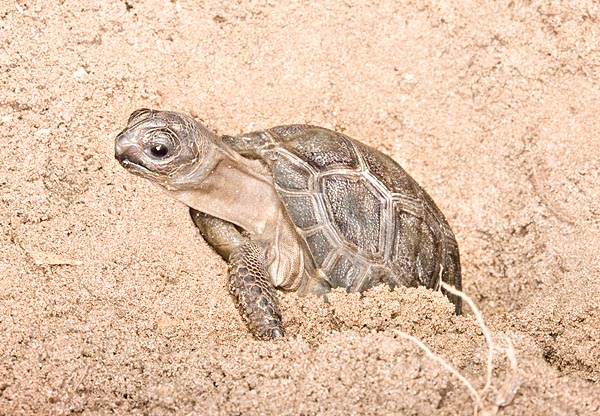 Once deposition is over, mama turtle puts again in the hole the mould which had been previously taken off, levels carefully the ground with the plate, and drags over it leaves and what else she finds around, so that nothing can reveal the presence of the nest.
Once deposition is over, mama turtle puts again in the hole the mould which had been previously taken off, levels carefully the ground with the plate, and drags over it leaves and what else she finds around, so that nothing can reveal the presence of the nest.
This is the last act of love, as later, when she leaves, she will not take care any more of the young.
Incubation is entrusted to the temperature of the air. In Curiose, normally, 90 -110 days are needed.
When they have completed their growth, the young in the first place pierce the egg with the “tooth”, a horny sharp thickness which soon later will fall down.
Then several hours are needed till, following the pushing of the lungs, the carapace expands, crumbling the shell.
They eat it in small pieces. They make their own way, yawning between the efforts, and finally they succeed in getting rid of the shell and break the cord.
Generally, the small turtles draw out of the soil after 1-2 days of efforts, but when atmospheric conditions are not favourable, they can easily wait in the darkness even for 6 months.
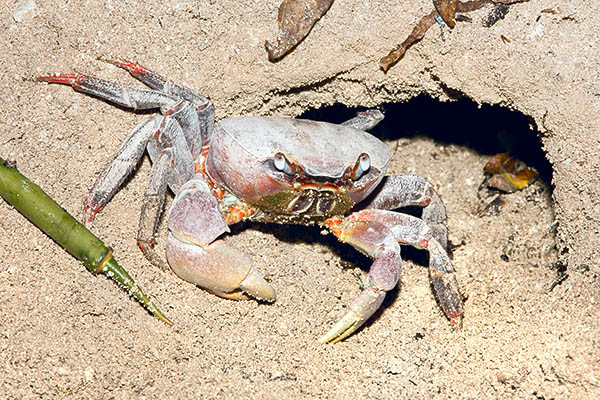 Unfortunately, a good half of the eggs is not fertile, and even before the birth, pillagers are going around.
Unfortunately, a good half of the eggs is not fertile, and even before the birth, pillagers are going around.
The most dreadful are the land crabs (Cardisola carnifex), true and real executioners, as the Latin name suggests.
Mainly, they eat vegetables. The specimen close by, for instance, was not running away even upon my arrival, for fear of loosing the mangrove fruit which had just fallen on the left of his den. But, they have a weakness for turtles eggs.
Being very smart in digging, they reach the nests under the ground and wreak havoc.
Last oddness: during incubation, it’s the temperature which determines the sex of Seychelles turtles.
It was the same thing for dinosaurs. And it looks like that they extinguished just because, due to a sudden change of climate, only males were coming to birth.
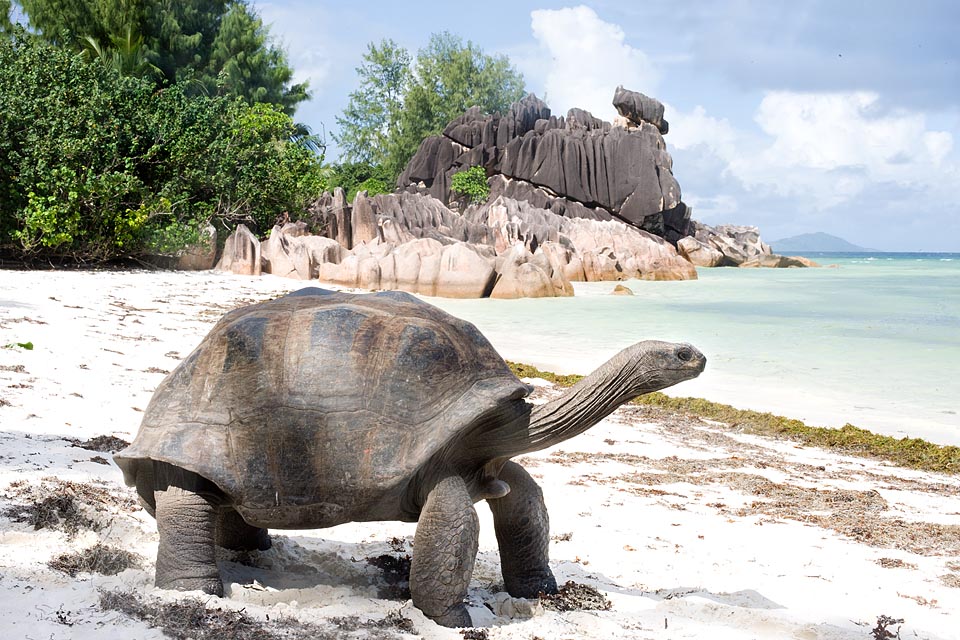
– 2008 –
→ For general notions about Testudines please click here.
→ To appreciate the biodiversity within the TURTLES please click here.
